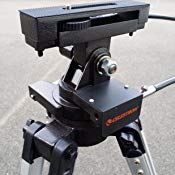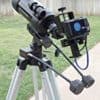There seem to be so many types of telescope mounts mentioned on the internet and even on the boxes of new telescopes brag this type of mount up. Let’s find out what Alt-Azimuth means and if it is good or not.
An alt-azimuth mount is a simple type of telescope mounting. As its name suggests, it will be able to vary your telescope’s altitude and azimuth. Altitude is simply up or down while azimuth is left or right. You can adjust the telescope’s altitude and azimuth to follow an object across the night sky. Think of it as a camera stand with “pan & tilt” action.
Why Use an Alt-Azimuth Mount?
When viewing the moon, the stars, and all other celestial objects, you have to take into account the Earth’s rotation. It makes all celestial objects appear to move throughout the night sky. You may not be able to notice this with your naked eye because they seem to move very slowly, but with a telescope, it is indeed noticeable. It takes an object about a minute (or even less for more powerful telescopes) to cross from one edge of your eyepiece to the other. To be able to keep observing it, you must be able to move your telescope to track its movement. The problem is, the motion of these celestial objects are constant, and you must be able to adjust your telescope frequently and in very tiny increments. This is where the Alt-Azimuth Mount comes in.
How do you Setup an Alt-Azimuth Mount?
Setting up an alt-azimuth (alt-az) mount can vary from manufacturer to manufacturer, but the necessary steps are the same.
 Mounting your telescope on an alt-az mount. Different telescopes may have different ways of attaching to the alt-az mount. If you bought your telescope with an alt-az mounting, this will be super easy and straightforward. For telescopes and mounting that are sold separately, you will have to make some minor adjustments. Telescopes that are explicitly designed for this kind of mount, use metal clamps that hold the telescope tube while also having threaded holes for attaching to the mount.
Mounting your telescope on an alt-az mount. Different telescopes may have different ways of attaching to the alt-az mount. If you bought your telescope with an alt-az mounting, this will be super easy and straightforward. For telescopes and mounting that are sold separately, you will have to make some minor adjustments. Telescopes that are explicitly designed for this kind of mount, use metal clamps that hold the telescope tube while also having threaded holes for attaching to the mount.- Problems may arise when your telescope is not compatible to your alt-azimuth mount. The holes on each may not line up with each other. If this is the case with your telescope and mount, you will have to do some extra work of drilling holes in the proper spot or buying adapters that can compromise for any incompatibility. Many offer clamps that go around your telescope tube and have a machined surface to interface with. This is where the next step of balancing your mount plays a more significant role.
 Balance the mount. When buying an alt-az mount stand to connect your existing telescope to. You should first put all the accessories that you will use throughout your viewing (eyepieces, finder, etc.) on your telescope. Then loosen the mount’s mechanism that holds the up/down motion of the telescope. Move the entire telescope forward or backward until it does not move on its own after releasing it.
Balance the mount. When buying an alt-az mount stand to connect your existing telescope to. You should first put all the accessories that you will use throughout your viewing (eyepieces, finder, etc.) on your telescope. Then loosen the mount’s mechanism that holds the up/down motion of the telescope. Move the entire telescope forward or backward until it does not move on its own after releasing it.- Tighten your mount’s friction clutches to support the telescope so that it does not move.
Guess what that is pretty much it. Pick a moon crater to view and see how you can keep it in your view by turning your slow motion knobs to turn it left and right, or up and down.
Can You Use It for Distant Objects like Planets
You can use it to view anything. It gets more difficult to see the objects as your magnification increases, so the appearance of movement increases as well. The spin of the earth rotates and makes the object appear to move. This is where an Equatorial Mount as advantages.
What are Advantages and Disadvantages of Using an Alt-Azimuth Mount?
The advantage of the alt-azimuth mount is that it is simple and relatively cheap. It would be an excellent mount for beginners, especially children on their own. Because it does not take much effort in learning how to set up and use it. Its controls, which are basically just up or down and left and right are also intuitive and correspond to the natural way in which we categorize directions. In observing celestial objects that are relatively closer and brighter like the moon or even some of the planets, an alt-azimuth mount can be as useful as other telescope mounting types. The disadvantages of an alt-azimuth mount are that it cannot track objects as they move in the sky. Also because of this, it is not ideal for use in astrophotography, but it can be done.
| Telescope Mount | Advantages | Disadvantages |
| Alt-Azimuth |
|
|
What Are Other Types of Telescope Mounts?
The other type of telescope mount is the equatorial mount. This kind of telescope mounting allows you to follow the stars and other celestial objects as they move across the night sky.
An equatorial mount can move about on two axes: the right ascension (east to west) and the declination (north to south). Because you align this mount with the North Star, Polaris it gives you a reference in the night sky, so only one slow-motion knob is needed to track a celestial object.
 Computerized mounts: come in both Alt-azimuth and Equatorial style. But you are using computer controlled software to locate and track the items. Thus, as in CNC equipment, computer control can move both axes at the same time to follow that object across the night sky.
Computerized mounts: come in both Alt-azimuth and Equatorial style. But you are using computer controlled software to locate and track the items. Thus, as in CNC equipment, computer control can move both axes at the same time to follow that object across the night sky.
Need More?
If you want to learn more about what computerized mounts or tracking check out these articles;
Will Montgomery breaks down how Alt-Azimuth mounts work — and why he often recommends them to new stargazers looking for simplicity and ease of use.


